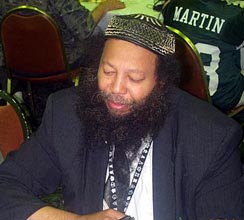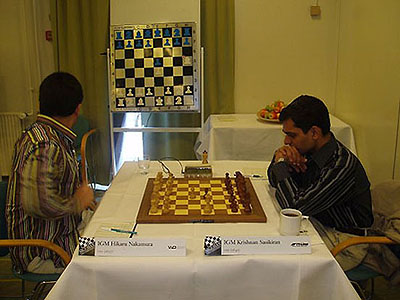The ‘Matrix Man’ still at it!

Bernard Parham, I
Photo by Daaim Shabazz.
Bernard Parham has a claim to fame. No it is not as the 1967 Indiana State Champion, or even as a long-time chess educator. He is famous for something else… “The Matrix System of Chess.” This system was created decades ago when Parham had a fascination with the geometric patterns of chess after seeing a connection with vector analysis and physics. He employed a system that appeared so crude that it has brought as many critics as it has advocates. Parham has created a system that apparently defies the accepted principles of chess. He also has set different values for the pieces and even has a separate, albeit more logical, way of recording moves.
What is this Matrix System? It involves positioning the pieces in order to arrive at the earliest possible checkmating positions. One element of this system is dubbed the “Parham Attack.” It entails playing an early Q-KR5 or Q-KB3… or both! Opening moves would be 1.e4 e5 2.Qh5!? Nc6 3.Bc4 or 1.e4 c5 2.Qh5?! He has even employed 1.e4 c6 2.Qh5!? What would appear to be a “Scholar’s Mate” actually has some theoretical underpinnings laid out in Parham’s Matrix System of Chess.
His name surfaced when GM Hikaru Nakamura became the first world-class player (in the modern era) to employ the opening in a classical tournament. Nakamura, the perfect ambassador for this experiment, would employ it several times with mixed results. The opening actually picked up the moniker “H-Bomb” and ignited a fierce debate on the opening and the possibility that old laws of chess can be challenged.

Hikaru Nakamura appears to glance at 2.Qh5!? on the demo board as India’s Krishnan Sasikiran ponders. Nakamura got the idea to play the move from Jason Doss during a chat on the ICC. Doss is one of Parham’s former students, but his urging was initially a light-hearted joke. What was initially a joke turned into reality when Nakamura played 2.Qh5. Photo by Sigeman & Co., 2005.
It was a healthy debate and a successful coup for Parham. That last word is that the opening is risky (at best), but playable. The most challenging line is 1.e4 e5 2.Qh5 Nf6!? 3.Qxe5+ Be7 with good play for Black. Parham has played this opening for 45 years and was pleased to see the ideas tested on the highest level.
With a long-time relationship with Purdue University, Parham has returned to finish his education. He was featured in the student newspaper and has been instrumental in spurring activity at the Purdue Chess Club. He has taught over 6,000 students his chess philosophy. Now at 64, he was quoted in a recent article as being proud of reaching an age that is symbolic of chess. Since 64 represents a perfect number in many ways, the Matrix appears to be real!
Article: https://www.purdueexponent.com/index.php/module/Section/section_id/3?module=article&story_id=20435
Interview: Bernard Parham on the Matrix System (The Chess Drum)

Daaim,
Chess as an art allows for a lot of creativity. Anything is possible! The opening should have been named the “B-bomb” after “Bernard”!
Kewl,
Ian
Ian,
“B-Bomb” 🙂 Hikaru actually took a bit of flak because the H-Bomb being the weapon that leveled Hiroshima and Nagasaki, cities in the land of his birthplace. However, it was a great experiment.
The Matrix System of Chess (MSC) is definitely interesting, but the ideas have not been fully investigated. The player that seems to exemplify the MSC (besides Nakamura) is Veselin Topalov. Topalov energy and direct approach is exactly what Parham advocates.
Parham has given the rook and bishop equal value. Both have two spokes, but the bishop’s plane is rotated 45 degrees. Of course, the bishop is able to attack along its planes much more swiftly. The theory challenges power (rook) vs. agility (bishop). The rook covers more ground, but takes them awhile to exert the full power. In practice, it appears that Topalov has given us so many examples of how a rook can be traded for a bishop with adequate compensation. Perhaps Parham should examine these games and make a case.
His notation system is logical is intriguingly logical. The symbols show the direction of movement, so a rook’s symbol is “+” and the bishop’s is “x” (See the MSC symbology). It makes it so much easier to go over a game without the use of a board.
(Note: It’s interesting that the Emory Tate variation of the Alekhine got some discussion many years ago. The variation goes. (1.e4 Nf6 2.e5 Nd5 3.c4 Nb6 4.a4!? a5 5.Ra3!!?) If black plays 5…e6, the white plays 6.Rg3! for a swift attack.)
I just read my interview with Parham years ago and remember that his value for the queen (six points) is adding not merely the value of the pieces, but the geometric pattern of each bishop (since the queen can move on both color of diagonals) and the geometric pattern of the rook. I’m not sure if I buy this piece value of the queen, but of course in the initial stages of the game, the queen attacking quickly can overwhelm minor pieces.
It is interesting the note that the value of each piece can change after each move. The rook is worthless as long as it’s hemmed in, but unleashes power as game opens. Ironically, I recall many games where the rooks are still in the corners when the game has ended. The loser played essentially without two rooks.
I had the pleasure of meeting Mr. Parham this past weekend at the Queen City Classic in Ohio. He spoke with Diamond and took a picture with her. I felt honored to meet Mr. Parham and he was very kind to my daughter. Looking forward to learning more about Matrix Chess!
It is always great to see creative ideas…I think the point of coming up with your own ideas and using them is becoming a lost art in chess. An IM once told me that sub 2400 the openings play such a small role in the outcome of the game anyway. If you believe in what you play, YOU CAN WIN!
Hey I like the emory tate attack…I am going to try it out in some blitz games…never seen that before!
There are some games in the database with the Tate variation.
Mark Bowen of Jamaica found this thread on chess.com on Parham’s Matrix system…
https://www.chess.com/forum/view/chess-openings/matrix-chess-is-back